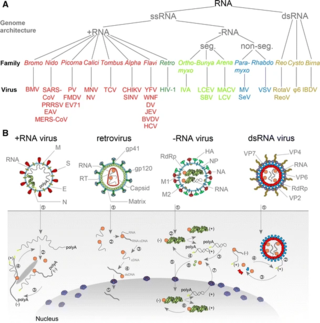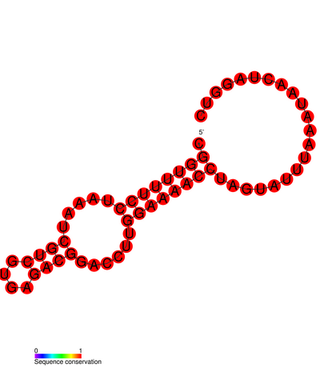
An RNA virus is a virus—other than a retrovirus—that has ribonucleic acid (RNA) as its genetic material. The nucleic acid is usually single-stranded RNA (ssRNA) but it may be double-stranded (dsRNA). Notable human diseases caused by RNA viruses include the common cold, influenza, SARS, MERS, COVID-19, Dengue Virus, hepatitis C, hepatitis E, West Nile fever, Ebola virus disease, rabies, polio, mumps, and measles.
A satellite is a subviral agent that depends on the coinfection of a host cell with a helper virus for its replication. Satellites can be divided into two major classes: satellite viruses and satellite nucleic acids. Satellite viruses, which are most commonly associated with plants, are also found in mammals, arthropods, and bacteria. They encode structural proteins to enclose their genetic material, which are therefore distinct from the structural proteins of their helper viruses. Satellite nucleic acids, in contrast, do not encode their own structural proteins, but instead are encapsulated by proteins encoded by their helper viruses. The genomes of satellites range upward from 359 nucleotides in length for satellite tobacco ringspot virus RNA (STobRV).

Lettuce mosaic virus (LMV) is a typical potyvirus, which causes one of the major virus diseases of lettuce crops worldwide.

Closterovirus, also known as beet yellows viral group, is a genus of viruses, in the family Closteroviridae. Plants serve as natural hosts. There are 17 species in this genus. Diseases associated with this genus include: yellowing and necrosis, particularly affecting the phloem. This genus has a probably worldwide distribution and includes among other viral species the Beet yellows virus and Citrus tristeza virus, rather economically important plant diseases. At least some species require vectors such as aphids or mealybugs for their transmission from plant to plant.

Crinivirus, formerly the lettuce infectious yellows virus group, is a genus of viruses, in the family Closteroviridae. They are linear, single-stranded positive sense RNA viruses. There are 14 species in this genus. Diseases associated with this genus include: yellowing and necrosis, particularly affecting the phloem.

Nepovirus is a genus of viruses in the order Picornavirales, in the family Secoviridae, in the subfamily Comovirinae. Plants serve as natural hosts. There are 40 species in this genus. Nepoviruses, unlike the other two genera in the subfamily Comovirinae, are transmitted by nematodes.

Curly top is a viral disease that affects many crops. This disease causes plants to become smaller in size, have shriveled petals and leaves, and are twisted and pulled out of shape. They are often caused by curtoviruses, members of the virus family Geminiviridae. This disease is important in western United States, such as California, Utah, Washington, and Idaho.

Partitiviridae is a family of double-stranded RNA viruses. Plants, fungi, and protozoa serve as natural hosts. It has been suggested that they can also infect bacteria. The name comes from the Latin partitius, which means divided, and refers to the segmented genome of partitiviruses. There are five genera and 60 species in the family, 15 of which are unassigned to a genus.
Luteovirus is a genus of viruses, in the family Tombusviridae. There are 13 species in this genus. Plants serve as natural hosts. The geographical distribution of Luteoviruses is widespread, with the virus primarily infecting plants via transmission by aphid vectors. The virus only replicates within the host cell and not within the vector. The name 'luteovirus' arises from the Latin luteus, which is translated as 'yellow'. Luteovirus was given this name due to the symptomatic yellowing of the plant that occurs as a result of infection.

The Upstream pseudoknot (UPSK) domain is an RNA element found in the turnip yellow mosaic virus, beet virus Q, barley stripe mosaic virus and tobacco mosaic virus, which is thought to be needed for efficient transcription. Disruption of the pseudoknot structure gives rise to a 50% drop in transcription efficiency. This element acts in conjunction with the Tymovirus/Pomovirus tRNA-like 3' UTR element to enhance translation.

Beet curly top virus (BCTV) is a pathogenic plant virus of the family Geminiviridae, containing a single-stranded DNA. The family Geminiviridae consists of nine genera based on their host range, virus genome structure, and type of insect vector. BCTV is a Curtovirus affecting hundreds of plants. The only known vector is the beet leafhopper, which is native to the Western United States.

Beet necrotic yellow vein virus (BNYVV) is a plant virus, transmitted by the plasmodiophorid Polymyxa betae. The BNYVV is a member of the genus Benyvirus and is responsible for rhizomania, a disease of sugar beet that causes proliferation of thin rootlets, and leads to a smaller tap root with reduced sugar content. Infected plants are less able to take up water, and wilting can be observed during the warm period of the year. If the infection spreads to the whole plant, vein yellowing, necrosis and yellow spots appear on the leaves, giving the virus its name.
Beet yellow net virus (BYNV) is a plant pathogenic virus of the family Luteoviridae.
Beet yellows virus (BYV) is a plant pathogenic virus of the family Closteroviridae. Beet yellows virus is transmitted by multiple species of aphid and causes a yellowing disease in Beta vulgaris and Spinacia oleracea.

Benyvirus is a genus of viruses, in the family Benyviridae. Plants serve as natural hosts. There are four species in this genus. Diseases associated with this genus include: BNYVV: rhizomania.

Macrosiphum euphorbiae, the potato aphid, is a sap-sucking pest insect in the family Aphididae. It infests potatoes and a number of other commercially important crops.
Polerovirus is a genus of viruses, in the family Solemoviridae. Plants serve as natural hosts. There are 26 species in this genus. Diseases associated with this genus include: PLRV causes prominent rolling of the leaves of potato and a stiff upright habit of the plants; necrosis of the phloem and accumulation of carbohydrates in the leaves.
Beet pseudoyellows virus (BPYV) is a species of virus in the genus Crinivirus.

Beta macrocarpa, the large-fruited beet, is a species of flowering plant in the family Amaranthaceae, native to the Canary Islands and the shores of the Mediterranean. It is widely used to study beet necrotic yellow vein virus in an effort to improve the sugar beet.












